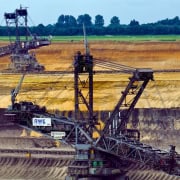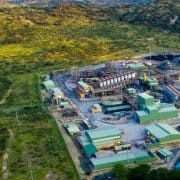|
Getting your Trinity Audio player ready...
|
Corruption Watch (CW) has done extensive work in the field of mining royalties, especially in terms of benefits that should be flowing to mining-affected communities as recompense for the disruption to their lives and lands.
Two CW reports set out the challenges faced not only by the communities, but also by activists and organisations working on their behalf. The first Mining Royalties Research Report found widespread corruption in the failure to provide the most-affected communities with equity benefits and compensation flowing from mining on their land. As a result, those most affected by mining activity continue to live in poverty and hardship without having benefited from mining operations in their areas.
“That was not a standalone report,” said Mashudu Masutha, CW legal researcher in extractives, at a webinar held on 12 August 2021 to mark the launch of a follow-up to this report. “The Public Protector looked into the Bapo ba Mogale community, and found over R600-million that had been siphoned out. The Baloyi commission of inquiry looked into the Bakgatla ba Kgafela community in the North West, where again millions were siphoned.”
The second report, Improving Transparency and Accountability in the Flow of Benefits to Mining Communities, was released with an accompanying Legal Review: Distribution of Mining Equity to Community Trust. It not only emphasises the persistent challenges reflected in the first report, but also suggests interventions that will best shape mechanisms designed to channel benefits to communities, while improving transparency and accountability, and clamping down on corruption.
This form of looting has gone largely under the radar, Masutha said. “It’s not on any policy agenda, it’s not tabled with portfolio committees, it’s not addressed by policy makers.”
The continued exclusion of communities from the consultation and agreement process is a major factor in the rise of corruption and mismanagement in the mining royalties process, and has long-lasting adverse effects on the affected people because they suffer the consequences of decisions they did not make.
Rural communities exploited and excluded
Sociologist Prof Sonwabile Mnwana, a guest speaker at the CW webinar, set the scene for the development of the current environment.
“Mining occurs largely in the former homeland areas, especially in the case studies that have been highlighted in the report,” he said. “As some of us might know, these were spaces of marginalisation, by and large, for black people.”
Those areas, Mnwana explained, were designed by the colonial and apartheid states to confine the majority of citizens of South Africa into poverty and landlessness.
“The customary systems of tenure which Africans have preserved for centuries … are the only way through which villagers could have access to land, and any form of immovable property and land for farming.”
Land is a safety net in these areas, he added. And when it comes to mining, the situation is complicated by the occurrence of platinum group metals on land that is held under customary systems of tenure. Most of the land is assumed to be under administrative control of local traditional authorities, which are empowered to act on behalf of the communities they lead.
The Mineral and Petroleum Resources Development Act (MPRDA) defines community as:
“a group of historically disadvantaged persons with interest or rights in a particular area of land on which the members have or exercise communal rights in terms of an agreement, custom or law: Provided that, where as a consequence of the provisions of this act, negotiations or consultations with the community is required, the community shall include the members or part of the community directly affected by mining on land occupied by such members or part of the community”.
In a submission to the parliamentary committee on mineral resources and energy, on behalf of the Land and Accountability Research Centre (LARC), former LARC head Aninka Claassens pointed out that decision-making usually starts with councils and traditional leaders who represent the traditional communities formerly referred to as ‘tribes’.
In reality, she said, the people directly affected by mining are never whole ‘tribes’ but always families and sub-groups whose homes, fields and grazing land are targeted for mining activities.
So who are the rightful beneficiaries?
One particular area of clarification in the latest CW report focuses on identifying and establishing exactly which people should benefit from mining operations.
“Identifying the communities who are most impacted by mining operations and who deserve to be the recipients of benefits, is critical. Doing so is complex and contentious, as there are layers of people affected,” the report notes.
The recipients are not the traditional authorities, government officials, consultants, mine company employees and others that have jumped at the chance to reap the financial advantages of mining operations – at the expense of the rightful beneficiaries. As pointed out by Claassens, the latter group comprises the households immediately affected by mining, as well as surrounding communities who, while not directly impacted, do bear negative consequences of mining operations.
The Wilgerspruit case study in the CW report is a good example of this, and is one which has become a protracted struggle for the villagers and descendants of the original purchasers of the Wilgerspruit farm, against a mining company and their own traditional leaders. It finally ended up in the Constitutional Court. Known as the Maledu case, it centres on the purchase of the farm in 1919 by a group of villagers, who were compelled to register the land under a recognised Bakgatla ba Kgafela chief as black people were not allowed to own land at that time.
“The land was held in trust for the Bakgatla tribe, and was kept by the state,” said Mnwana.
This is one of the problems identified in the CW report, in that despite the land having been purchased by members of a specific Bakgatla village, the title deed reflected that the then minister of Bantu Administration and Development held it in trust on behalf of the entire Bakgatla community, which is spread out over a far greater area than that directly affected by mining.
So when some mining exploration took place on the land almost a century later, the people who owned the land were not consulted, as the mining company, believing the land to belong to the whole community as reflected in the title deed, negotiated only with the chief, despite protests from community members.
An agreement struck between the chief and the mining company, the villagers learned later, was worth R900-million, of which they did not see a cent. They also learned that the chief and the mine planned to evict them from their legitimately owned land. They obtained legal representation, which was able to halt the mining operations through an interdict. A fight-back by the mine culminated at the Constitutional Court, which held that mining rights do not trump the constitutional rights of the occupiers of the land.
After intense negotiations, the mine and the community entered into a comprehensive settlement agreement that included significant monetary compensation to the community, and a progressive social and labour plan.
Mnwana commented: “One of the key causes of conflict, one could argue, are attempts in the post-apartheid era, by the state in collusion with mining capita, to redefine rural residents living in these former homeland areas as traditional communities.”
This is no different to the way the apartheid state defined Africans in these areas as tribal authorities in the 1950s, he said, and later confined them under the authority of the homeland leaders. This interpretation of apartheid legislation is playing an increasingly significant role in mediation between local communities and mining corporations.
“There’s also an overemphasis, by the state, on the geographical location in defining and identifying the so-called communities or traditional communities.”
Recommendations
Because community trusts, and the mining benefits into which they are paid, are highly vulnerable to unscrupulous and corrupt interests, all parties involved must endeavour to operate in a way that is inclusive, transparent, and based on a commitment to ensuring that mining benefits flow to where they must.
The new CW report seeks to understand and recommend avenues through which such transparency and accountability can be achieved, by means of legal and policy considerations. These will enable communities to not only have the transparency and accountability they desire, but will also ensure economic mobility for these communities.
The complexities in both traditional and mining communities must be taken into account, Masutha said, for the revised legal framework to be considered best practice.
- Identify the beneficiaries: This starts with clear, sufficiently objective, measurable criteria as to who the beneficiaries are. It must be possible to apply an objective test to determine who qualifies to be a beneficiary.
- Clear definition of entitlement: The DTI Codes of Good Practice requires a written record of fixed percentages of entitlement or the use of a formula for calculating entitlement. The percentages are highlighted in the Codes.
- Clearly stated objects: As the directly affected households and people in clearly defined geographical areas near the mine, the community that has the right to benefit from the equity from the mine must decide on the objects of the trust.
- Appoint appropriate representatives: A key to ensuring trustees are accountable is the presence on trusts of people either closely connected to the community in that they come from the same area and have a historic and/or familial interest in the community benefiting from the mine, or members of civil society or equivalent organisations that have a commitment to the broader goals of poverty alleviation and equity.
- Appointment of trustees: The trust deed needs to stipulate that community trustees must be appointed in a manner that ensures they are true representatives, and could spell out a process.
- Amendment of instrument: Trustees must not be empowered to amend the trust deed on a whim, as this could lead to fraudulent and unaccountable action being taken.
- Term of office: A fixed term should be set because it acknowledges the need for – and ensures – innovation, fresh ideas and diversity.
- Democratic decision-making: Decision-making has to be in the interests of the beneficiary community, and this requires a level of community participation in the affairs of the trust.
- Management of the trust: Trusts must have operational capacity, which must be in the form of skilled staff and/or part-time advisors, if the trust is small. If the trust does not have major assets, an office and premises may not be practical. But separation of the role of trustee from that of staff is key to good governance and the trust deed should provide for this.
- Transparency and information: The Department of Trade and Industry’s Codes of Good Practice require that in regard to a broad-based ownership scheme, the statutory document must be available on request to any participant in the language with which they are familiar. The scheme’s financial reports must be presented to the participants at an AGM.
- Distribution and expenditure: The trust deed should define the minimum contributions that beneficiaries must receive annually and should make it mandatory for a minimum value to be dispersed annually.
- Diversification: The trust must not be restricted to only mining equity or income from the mine. In order to meet community expectations, other investments must be made in, for example, solar projects, farming initiatives, etc.
- Accessibility: Communities must not be excluded in consultations, nor must they be unable to access information about what is going on.
- Conflict resolution: This could be an area where a chief could play a role. They have much more to offer when they are at arm’s length from a trust. In many traditional communities, chiefs and traditional leaders have been seen as mediators when conflicts occur.
- Ombud: An ombudsman could act as an oversight office in regard to the Department of Mineral Resources’ role in monitoring compliance with the MPRDA.
- Capacity: Communities require capacity to be actively involved in the management of trust assets. One way to do this is to formulate a plan with community buy-in and involvement that informs the projects and activities of the trust.








